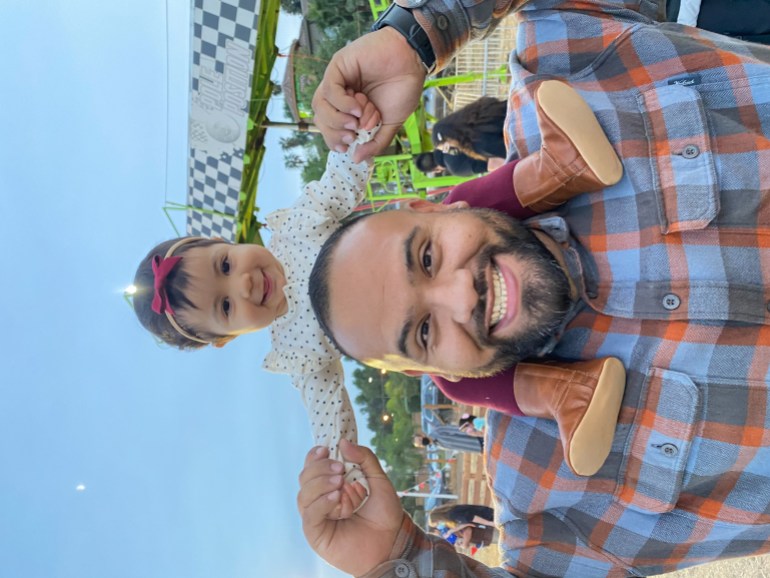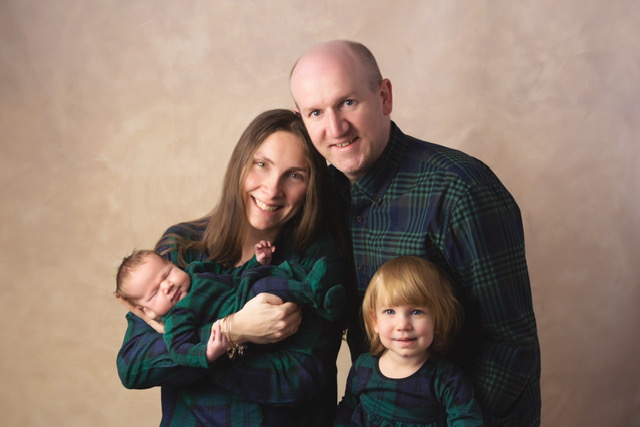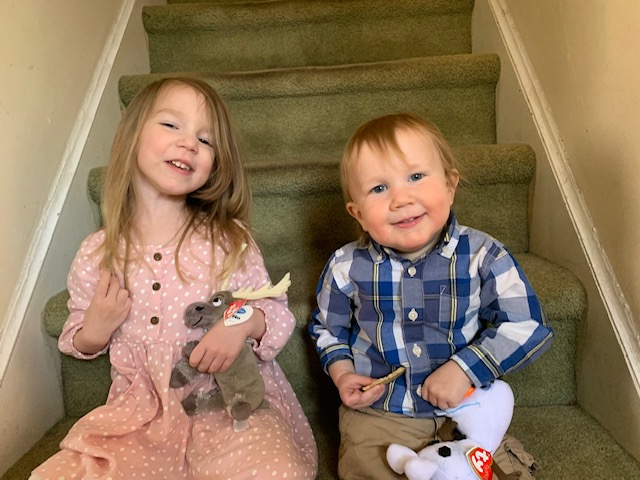‘No going back to normal’: 43,000 US kids lost a parent to COVID
Ebony James’s 20-year-old son sometimes sits in his car for hours after he parks inside the family’s garage. Her eight-year-old stopped sleeping in his own bed after his dad no longer sat with him reading the Bible until he fell asleep. Her 16-year-old daughter “completely shut down and just didn’t talk at all”.
This is how they are processing the sudden death of their father, Terrence, 49, from COVID-19 in February.
“Their reaction is a little bit different than mine. I notice that when I try to talk to them about their dad, they don’t want to talk. They just don’t, and that part hurts because sometimes I do,” James, 49, told Al Jazeera. “What do you do with that?”
Beyond the heartbreak of losing her best friend and husband of 10 years, James, an education administrator, now also faces a life she had never imagined for herself as a 49-year-old widow and single mother of three children. In addition to the grief, she worries how she will make ends meet for them all.
In the wake of Terrence’s death, there were immediate costs: her own medical bills after being hospitalised for COVID-19, a $2,000 payment to a lawyer to put the house Terrence had bought before their wedding in her name — and another $16,000 for his funeral and burial after his life insurance policy lapsed. Bills racked up for counselling sessions for her children as they navigated their own grief.
James now wonders if she can afford to pay the mortgage on their house in Fresno, Texas alone. Will she need to sell their cars? She applied for Medicaid and food stamps and was denied, she said; her children are now uninsured because she hasn’t been able to afford a health insurance plan for them.
Her older son pitches in with money from his job — help she wishes she didn’t need. Her daughter will have to leave the prestigious high school she attends.
“She is now going to have to go to the school within the neighbourhood, which is not a very good school,” James said. “I just told her that she’s going to have to get the highest grades in the class because I need her to get a scholarship. She wants to be a veterinarian, and I know that I can’t afford it.”
Across the United States, families are grappling with losses like James’s: as many as 43,000 children in the country are estimated to have lost at least one parent to COVID-19 by February, a study published in JAMA Pediatrics found, resulting in a “dramatic” 20 percent increase in parental bereavement compared to a typical year.
 Terrence James (right) died from COVID-19 on February 19, 2021, leaving behind his wife, Ebony, and their three children [Courtesy: Ebony James]
Terrence James (right) died from COVID-19 on February 19, 2021, leaving behind his wife, Ebony, and their three children [Courtesy: Ebony James]These losses are not only tragic for children, but can also lead to mental health problems, challenges in school and economic disparities that last for years, said Emily Smith-Greenaway, the study’s co-author and an associate professor of sociology and spatial studies at the University of Southern California.
“People are coping with these losses in a more isolated, economically precarious year for so many families,” Smith-Greenaway told Al Jazeera.
The study also found that Black children are disproportionately affected — although they comprise only 14 percent of children in the US, they represent 20 percent of those who lost a parent to COVID-19.
‘I can still hear him telling me to save and save and save’
As the US grappled with the early days of the coronavirus crisis, former President Donald Trump repeatedly downplayed its severity, falsely claiming the virus affects “nobody young”.
But that wasn’t Laura Guerra’s experience. Two days after celebrating her daughter Emilia’s first birthday, she watched from behind a sheet of glass as her 33-year-old husband Rodrigo took his final breaths on Christmas Eve.
“I remember just hitting the window and saying no — I couldn’t believe this was happening. He was healthy a month ago,” Guerra told Al Jazeera. “I stood there and watched until his heart just stopped.”
 Rodrigo Guerra, 33, died from COVID-19 on December 24, 2020, leaving behind his one-year-old daughter, Emilia, and wife, Laura [Courtesy: Laura Guerra]
Rodrigo Guerra, 33, died from COVID-19 on December 24, 2020, leaving behind his one-year-old daughter, Emilia, and wife, Laura [Courtesy: Laura Guerra]Guerra’s co-workers at a non-profit organisation banded together and donated 200 hours of their paid time off to her so she could stay home and care for her daughter for an extra month.
But she is now back at work and relying on her salary as a mental health specialist to keep up with the bills, afford daycare and pay the mortgage on her home in Riverside, California.
“There’s a lot of fear that just automatically comes in, a lot of the unknown,” Guerra, 33, said. “I am going to have to sell our house. I am going to have to sell our cars. I can’t pay my mother-in-law to watch my daughter anymore. I have to work full time.”
Costs for one infant in a daycare centre average $1,230 per month in the US, or nearly $15,000 per year, a 2018 analysis by the non-profit Center for American Progress found.
In no US state does this meet the level considered “affordable” by federal standards: no more than seven percent of the average annual household income.
Guerra’s daughter now receives a $1,700-per-month Social Security death benefit, she said, and the family may also qualify for workers’ compensation if they can prove Rodrigo, who was an essential worker at an engineering company, contracted COVID-19 on the job.
But that’s still not enough to make up for the financial blow delivered by Rodrigo’s death. His wife and daughter also lost his monthly veteran’s disability benefit, which he qualified for after serving with the US Marine Corps in Iraq and being injured by a roadside bomb in 2007.
When Rodrigo died, Guerra says, the benefit stopped — and the government asked her to pay back the cheque it had sent for the month of December, which she had already used to pay the mortgage. The money was later returned to her.
The couple used to set aside Saturday mornings to discuss their savings goals over coffee. Guerra is now struggling with a new reality, including planning for Emilia and her future alone.
“Now it’s like I have to do that on my own. I can still hear him telling me to save and save and save,” Guerra said. “I’m trying to be smart about paying off our house and not having any debt.”
‘You don’t expect to become a widow with young children’
Families who lost a parent to COVID-19 have seen dramatic shifts in their way of life — as well as their financial stability.
Pamela Addison’s 44-year-old husband, Martin, died of COVID-19 on April 29, 2020. He was a respiratory therapist at a New Jersey hospital and the father of a two-year-old daughter and five-month-old son.
 Martin Addison, 44, died from COVID-19 on April 29, 2020, leaving behind his wife, Pamela, and children, Elsie and Graeme [Courtesy: Pamela Addison]
Martin Addison, 44, died from COVID-19 on April 29, 2020, leaving behind his wife, Pamela, and children, Elsie and Graeme [Courtesy: Pamela Addison]“You don’t expect to become a widow, especially with young children. We had just had another baby and now it’s like it’s all on me,” Addison, 37, told Al Jazeera.
But as she grieves, Addison, an elementary school teacher, has also had to rework her life as a single parent of two.
Her entire paycheque goes to pay for daycare and her mortgage, she said, and she relies on savings to pay the other bills. She anticipates working longer, retiring later and shelving her own goal of going back to school.
“It’s kind of like your dreams are put on the side and you’re just trying to focus on surviving and figuring out how to make sure you don’t lose your house,” Addison said. “It’s about making sure my kids don’t miss out on something because I can’t afford it, because it’s just me.”
‘Our lives can’t go back to normal’
After Martin’s death, Addison received a letter from another young COVID-19 widow. That shared experience of pain helped her cope, she said, and inspired her to start a Facebook page called Young Widows and Widowers of COVID-19 to offer others the same comfort. It now has more than 500 members, who use it as a safe space to talk, vent and share information about what resources are out there.
But aside from this type of informal network, there is currently no tracking at the federal level of children who lost parents to COVID-19, said Smith-Greenaway.
 Following the death of her husband from COVID-19, Pamela Addison worries about being able to give their two children, Elsie and Graeme, the same quality of life they had dreamed of as a couple on only one income [Credit: Pamela Addison]
Following the death of her husband from COVID-19, Pamela Addison worries about being able to give their two children, Elsie and Graeme, the same quality of life they had dreamed of as a couple on only one income [Credit: Pamela Addison]That contrasts with other disasters, like the attacks of September 11, 2001, in which 3,000 children lost a parent and were tracked and provided with resources such as victim compensation, educational scholarships and help with navigating benefits available to them.
That’s why Smith-Greenaway is advocating for the creation of something akin to the 9/11 Commission to “task a particular branch of the federal government or particular agency to be in charge of identifying these children and providing supports to them,” she said.
“We need to make the administrative burden virtually zero so it’s very easy for people to get these funds quickly and immediately,” Smith-Greenaway added.
As the US economy begins to fully reopen this summer, these families also want to remind people that there is no going back to normal.
“I heard someone say that COVID is just going to be like a bad memory, but for so many of us, it’s a moment that changed our lives forever,” Addison said. “Our lives can’t go back to normal, because normal is when we had our husbands and our wives, when my children had their dad. We hate hearing that word.”
Source: Thanks AlJazeera.com